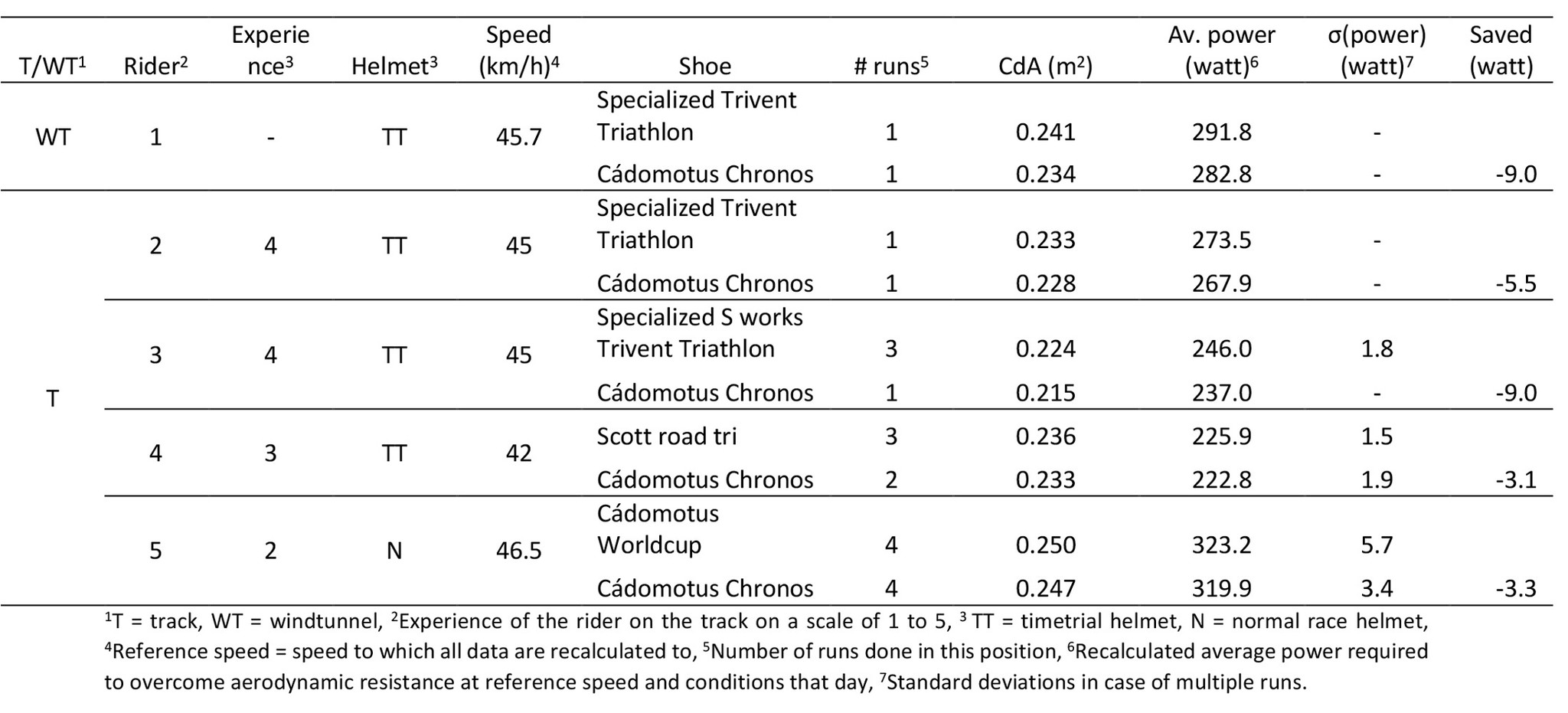Introduction
This study quantifies the aerodynamic advantage of the long-distance Cádomotus aero shoes over traditional race shoes on eight different triathletes. The number of watts saved by wearing the Cadomotus aero shoes compared to the riders' baseline shoes is calculated and reported.
"All athletes gained between 3.1 to 9.0 watts"
Results
The different shoes of the triathletes were categorized into two distinct groups. The first group is the typical triathlon shoe group. This shoe is designed for fast transitions which require a large instep, the shoes often have a single velcro strap to secure the foot into the shoe. The disadvantage of this type of shoe is the "open" structure of the shoe upper. Quite often, the foot is visible due to the presence of “holes” between the velcro straps which is aerodynamically not the best choice. In addition, the irregular shape at the front of the shoe and sometimes even at the back causes turbulence and irregular air flows. All athletes gained between 3.1 to 9.0 watts when using the Cádomotus long-distance aero shoes compared to their own “open” triathlon shoes designed for fast transition in sprint races (Table 1).
Table 1. Comparison between the “open” baseline shoes and the Cádomotus aero shoes.

The second shoe group does not contain the typical larger frontal “holes” but the more common road cycling shoe designs. The Specialized S works road shoes have a boa fit system to close the shoes, which demands more time during the transition but a better and stronger foot fit. The Shimano TR9 and Sidi T-4 air carbon shoes are closed with Velcro strips, but the holes on top of the shoe are significantly smaller than the baseline shoes discussed in table 1 with larger “holes”. In this case, the aerodynamic advantages of the Cádomotus aero shoes are between 2.1 and 4.5 watts (Table 2).
Table 2. Comparison between the “closed” baseline shoes and the Cádomotus Chronos aero shoes.

Experimental
All aero tests were conducted on the Eddy Merckx velodrome (Ghent, Belgium) during the winter of 2022/2023. The riders rode approximately eight laps of 250 meters with their triathlon bike and shoes. The riders repeated the procedure with the Cádomotus long-distance shoes. The bikes were equipped with a Garmin speed sensor and a power meter. Athletes kept the speed as fixed as possible to avoid errors and differences in rolling and mechanical resistance. Power was kept just below race pace to avoid tired athletes unable to properly reproduce their position between runs and within the same run and to obtain Reynolds numbers close to those obtained during a triathlon race. Software used to calculate CdA’s and the resulting power to overcome the aerodynamic resistance at current conditions (reference speed, pressure, humidity, temperature) was developed in-house by Streamline. Occasionally, athletes have repeated runs with the same shoes to calculate standard deviations and estimate reproducibility. The choice for repeating runs often depends on time and money. One athlete tested shoes in the wind tunnel of bike valley (Beringen, Belgium). Measurement time at the wind tunnel was 45s.
The tables above also contain extra information about the conditions of the measurements and athletes. (1) Larger errors are expected from riders with less track experience. The errors are due to the riding lines along the velodrome being less constant, inducing changes in rolling resistance and small correction by body movements to return to the original lines. The velodrome experience of the rider was estimated on a scale of 1 to 5, with the highest number for a highly skilled velodrome rider. (2) Using a traditional helmet increases the error in the measurement because of the relatively higher Cd coefficient of the helmet when it moves through the wind. (3) The higher the reference speed and the power required, the higher the difference between the baseline shoes and the aero shoes, and the higher the error on the measurement.

 Triathlon
Triathlon
 Outlet!
Outlet!
 CádoWiki
CádoWiki
 About Us
About Us









